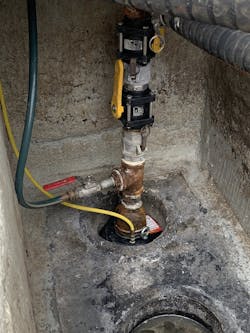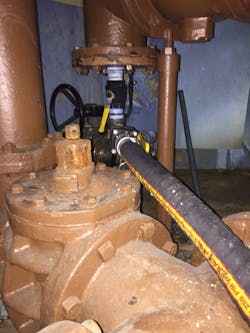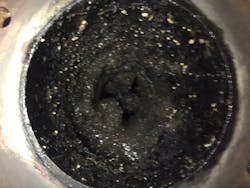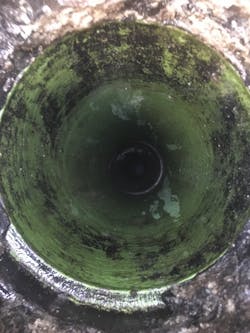About the author:
Jack Lawrence is the superintendent for Bethlehem, Pennsylvania Wastewater Treatment Plant. Lawrence can be reached at [email protected].
Sometimes, the efficient operation of a wastewater treatment facility comes down to a few pipes. If the flow in those pipes is reduced by a buildup of minerals like struvite, the operation suffers.
Such was the case at the Bethlehem (PA) Wastewater Treatment Plant (WWTP). Struvite had accumulated inside the three 8-inch, ductile iron overflow pipes between the three primary digesters and the secondary digester, choking the flow in the gravity-fed over a 25-foot run. This created operational headaches, continuously clogged the pipes and created backups. It became a daily challenge to keep the digested sludge flowing.
Struvite: A Challenging Adversary
Struvite buildups are a common problem. This crystalline structure composed of magnesium, ammonium and phosphate is a natural byproduct of wastewater treatment. Over time, struvite can accumulate in pipes, valves and pumps, creating a thick buildup as hard as concrete—and almost as stubborn to remove. Similar buildups can occur with other minerals, including vivianite (hydrated iron phosphate) and limestone (calcium carbonate). Typical areas for struvite to form include anaerobic digesters and associated pipes, valves, pumps and mixers; dewatering equipment; filtrate and centrate piping, valves and pumps; plant centrifuges; and heat exchangers. Over time, these buildups can dramatically reduce plant efficiency, increase unplanned downtime, shorten equipment life spans and increase energy use. They also resist removal using traditional maintenance methods.
The location of the pipes at Bethlehem’s digesters added to the challenge. Installed when the plant originally was constructed in the 1950s, the pipes were cemented into the structure, making replacement difficult. While the digesters had undergone major upgrades in 2017, these original pipes were not part of the project. A cost estimate to replace the three pipes came in at more than $80,000 and would have taken each primary digester out of service for up to a month. Not only was this cost and timeline not feasible, but there was no guarantee the replacement pipes would no longer experience the same struvite buildups.
The Struvite Fights Back
In an effort to keep the struvite at bay, Bethlehem contracted with an outside “Rooter” vendor to attack the buildup with high-pressure water jets at a cost of about $1,500 a visit. Over the course of a year, the facility spent about $20,000 on these services attempting to unclog the pipes. But the struvite continued to build up, making the pipe openings narrower and narrower.
The maintenance staff even tried to remove the struvite by using a length of steel conduit to chisel it out of the pipe, with little success. “The stuff is like cement,” said Maintenance Supervisor Drew Buskirk. Not only is the struvite hard, but it adheres to whatever is put in the pipe, so staff had to be careful not to end up with a piece of conduit stuck in the pipe, making matters worse.
When the staff decided to try mechanically drilling out the bottom of the pipes, two floors below, it was the facility’s and operator’s first look at just how extreme the struvite buildup had become. While the opening at the top was constricted by a few inches, the bottom of the pipe was about 90% blocked with an opening of about 1 inch in the worst case. This was a real wake-up call. The struvite was gradually blocking the pipes and no attempts to remove it seemed to work. Bethlehem needed a different approach, and management was willing to consider just about anything.
Chemical-based Approach
Workers heard about a new method of struvite removal by an industry salesperson, who mentioned a company in New Jersey called Grignard Company. This company had developed a proprietary chemical-based process that purported to remove struvite quickly and effectively. The documentation provided looked promising, so facility managers met with Grignard to learn more.
The process employs a proprietary chemical that binds with the magnesium ions in the struvite, breaking the molecular bonds of the struvite, removing it in solution and capturing it for proper disposal off-site. While other chemical methods have been used to remove struvite, such as ferric chloride (inorganic metal acid), these are not always effective and introduce hazardous, corrosive materials into the digesters, potentially impacting sludge quality and damaging equipment. The Grignard Company chemistry is non-corrosive, non-toxic, non-flammable and operator safe, with no hazardous fumes.
Methodical Process
Bethlehem managers gave the Grignard team the go-ahead and scheduled the project. The first step was a thorough inspection by the team to plan the project, which was estimated to take five days, cleaning one pipe at time to minimize disruptions to regular operations. The pH of the sludge was tested to assess the mineral composition and determine the dosing rate of the “struvicide” product and to establish a baseline to assess progress during the process.
The set-up for the work was straightforward. Bethlehem WWTP provided a balloon inlet cap for introducing the product at the top of the pipe and a flange at the bottom of the pipe with a 2-inch connection to facilitate recirculation back up to the top. Three 275-gallon totes of the struvicide product and a pump, supplied by the contractor, were placed by crane on the roof at the top of the pipe run.
Once everything was in place, the Grignard team introduced the product into the first pipe, recirculating it for eight hours. At the end of the day, the pipe was allowed to soak overnight. The following day, the pipe was flushed, and the contents pumped back into the tote for disposal. This process was repeated for the other two pipes in turn, so that the plant always had two pipes operational during the project. Throughout the process, we could see that the color of the liquid in the tote was changing, as the struvite in solution was recirculated into the tote. The pH was measured during the process, allowing the contractor to determine when the process was complete.
Free of Struvite
At the end of the project, Bethlehem inspected the pipes and found they were now approximately 99% clean of the struvite. To see the pipe restored to almost new condition so quickly and with little impact on operational efficiency satisfied the WWTP.
The next concern was how to avoid future struvite problems. Here, too, Grignard had a solution: a struvicide formula designed for preventive maintenance use. This non-toxic product is fed directly into the digester sludge feed line on a daily basis to prevent buildups of struvite and scale. It is formulated to go through the plant process and has had no impact on the sludge nor on dewatering in the centrifuges. Operators continue to inspect the pipes and the struvite accumulation seems to be under control.
Since performing the removal, the Bethlehem WWTP has experienced no backups or foaming issues or rags clogging in the pipe—all common occurrences before the project. With a proven strategy for winning the struvite battle, operators and workers can focus time and energy on its core mission: meeting the wastewater treatment needs of the Bethlehem community efficiently and cost-effectively.



